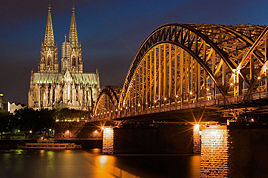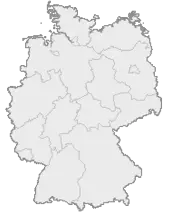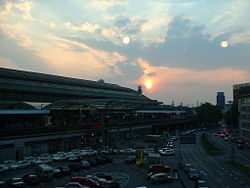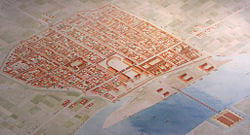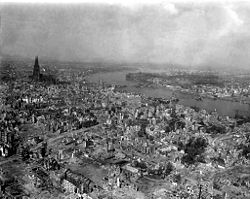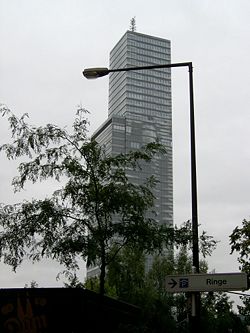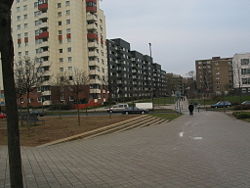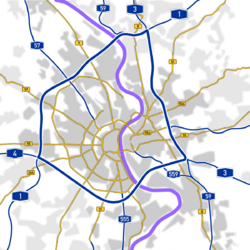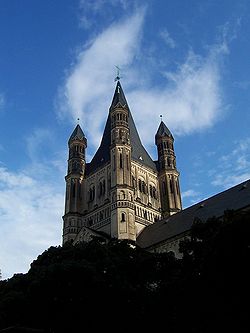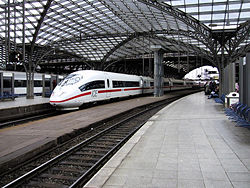Difference between revisions of "Cologne" - New World Encyclopedia
Mike Butler (talk | contribs) |
Mike Butler (talk | contribs) |
||
| Line 98: | Line 98: | ||
Germany is a federal republic in which the president is the chief of state elected for a five-year term by all members of the Federal Assembly and an equal number of delegates elected by the state parliaments. The chancellor, who is head of government, is elected by an absolute majority of the Federal Assembly for a four-year term. The bicameral parliament consists of the Bundestag of 614 members elected by popular vote under a system combining direct and proportional representation. In the Bundesrat, of 69 votes, state governments are directly represented by votes — each has three to six votes depending on population. | Germany is a federal republic in which the president is the chief of state elected for a five-year term by all members of the Federal Assembly and an equal number of delegates elected by the state parliaments. The chancellor, who is head of government, is elected by an absolute majority of the Federal Assembly for a four-year term. The bicameral parliament consists of the Bundestag of 614 members elected by popular vote under a system combining direct and proportional representation. In the Bundesrat, of 69 votes, state governments are directly represented by votes — each has three to six votes depending on population. | ||
| − | Cologne is the administrative centre of one of the five administrative districts of [[North Rhine-Westphalia]], which is one of Germany's 16 states. The city's elected council is headed by a [[mayor]] (''Oberbürgermeister'') and three deputy mayors. The state government controls welfare, planning, transportation, cultural affairs, among other government services. Cologne was the first city in Germany with a tax specifically for [[prostitution]]. The tax, initiated early in 2004 by the city council led by a coalition of the conservative CDU and the leftist Greens, amounts to 150 euros per month and working prostitute, to be paid by brothel owners or by privately working prostitutes. Prostitution in Germany is legal and widespread. | + | Cologne is the administrative centre of one of the five administrative districts of [[North Rhine-Westphalia]], which is one of Germany's 16 states, known in German as Länder (singular Land). (Düsseldorf is the capital of North Rhine-Westphalia.) The city's elected council is headed by a [[mayor]] (''Oberbürgermeister'') and three deputy mayors. The state government controls welfare, planning, transportation, cultural affairs, among other government services. Cologne was the first city in Germany with a tax specifically for [[prostitution]]. The tax, initiated early in 2004 by the city council led by a coalition of the conservative CDU and the leftist Greens, amounts to 150 euros per month and working prostitute, to be paid by brothel owners or by privately working prostitutes. Prostitution in Germany is legal and widespread. |
==Economy== | ==Economy== | ||
Revision as of 21:33, 28 August 2008
| Köln Cologne | |
| Cologne Cathedral with Hohenzollern Bridge | |
| Coordinates | |
| Administration | |
| Country | Germany |
|---|---|
| State | North Rhine-Westphalia |
| Admin. region | Cologne |
| District | Urban district |
| Mayor | F. Schramma (CDU) |
| Basic statistics | |
| Area | 405.15 km² (156.43 sq mi) |
| Elevation | 37 m (121 ft) |
| Population | 995,397 (31 December 2007) |
| - Density | 2,457 /km2 (6,363 /sq mi) |
| Founded | 50 |
| Other information | |
| Time zone | CET/CEST (UTC+1/+2) |
| Licence plate | K |
| Postal codes | 50441–51149 |
| Area code | 0221 |
| Website | www.stadt-koeln.de |
Cologne (Template:Audio-de, IPA: [kœln]; local dialect: Kölle [ˈkœɫə]) is Germany's fourth-largest city after Berlin, Hamburg and Munich. It is one of the oldest cities in Germany, having been founded by the Romans in the year 38 B.C.E. Cologne was granted the status of a Roman "city" in the year 50 C.E.
Cologne is a major cultural center of the Rhineland and has a vibrant arts scene. Cologne is home to more than 30 museums and hundreds of galleries. Exhibitions range from local ancient Roman archeological sites to contemporary graphics and sculpture. The city's Trade Fair Grounds are host to a number of trade shows such as the Art Cologne Fair, the International Furniture Fair (IMM) and the Photokina. Cologne is also well-known for its celebration of Cologne Carnival, the annual reggae summerjam, the largest of its kind in Europe, and the LGBT festival Christopher Street Day (CSD).
Geography
The name Cologne derives from the German name Köln, which in turn comes from the Latin word Colonia from the Roman name of the city — Colonia Claudia Ara Agrippinensium.
Cologne is located close to where the River Rhine enters the North German Plain, about 21 miles (34km) northwest of Bonn, 210 feet (65 metres) above sea level.
As part of the North-West German lowlands, and influenced by the Atlantic Ocean, and the North Sea, Cologne has a mild climate. The daily and yearly fluctuations in temperature are subdued, with an average maximum temperature in January of 35°F (1.5°C), rising to an average of around 66°F (19°C) in July. Mean annual precipitation is 28 inches (700mm), spread relatively uniformly throughout the year.
As an industrial location, Cologne was liable to high air pollution until well into the 1960s, made worse by increased in road traffic. Biologically, the Rhine was a dead river. Following the desulphurisation of smoke from the power stations, and the introduction of catalytic converters, air pollution has decreased. The introduction of purification plants has cleaned the Rhine and has attracted back many species of fish such as salmon.
Cologne covers an area of 156 square miles (405 square kilometers), with 85 districts divided into nine city areas. Most of the city is located on the left, or western, bank of the Rhine, with some suburbs on the right bank.
History
Wandering bands of hunters and gatherers such as Heidelberg man populated German forests about 400,000 years ago. Neanderthals, the remains of which were found near Düsseldorf, lived about 100,000 years ago. Around 4500 B.C.E., farming peoples from south-west Asia migrated up the Danube Valley into central Germany.
Roman Cologne
After Julius Caesar destroyed the Eburones in 53 B.C.E., the Roman general Agrippa (63-12 B.C.E.) colonized the area with the Germanic tribe, the Ubii, who founded Oppidum Ubiorum in 38 B.C.E. Cologne became acknowledged as a city by the Romans in 50 C.E. by the name of Colonia Claudia Ara Agrippinensium, named after the wife of Emperor Claudius. Considerable Roman remains can be found in contemporary Cologne, especially near the wharf area, where a 1900-year-old Roman boat was discovered in late 2007.[1] From 260 to 271 Cologne was the capital of the Gallic Empire under Postumus, Marius and Victorinus. In 310, under Constantine, built a castle and a bridge over the Rhine there.
Maternus, who was elected as bishop in 313, was the first known bishop of Cologne. The city was the capital of a Roman province until occupied by the Franks in 459. In 785, Charlemagne made Cologne an archbishopric.
The Middle Ages
From 962 to 1517, the Archbishop of Cologne was one of the seven prince-electors and one of the three ecclesiastical electors of the Holy Roman Empire. The archbishops had ruled large temporal domains. Cologne's location on the river Rhine, which placed it at the intersection of the major trade routes between east and west, was the basis of Cologne's growth. The archbishop received tolls, customs duties, and other payments until 1288, when Sigfried II von Westerburg (elector from 1274-1297) was defeated in the Battle of Worringen and forced into exile at Bonn. The city became a Free Imperial City, a status that was officially recognized in 1475..
The economic structures of medieval and early modern Cologne were characterized by the city's status as a harbor and transport hub upon the Rhine. Craftsmanship was organized by self-administrating guilds, some of which were exclusive to women. Cologne was a member of the Hanseatic League, an alliance of trading guilds, which existed from the 13th century to 17th century. The archbishop retained the right of capital punishment, so the municipal council, which in other ways opposed the archbishop, depended upon him for criminal jurisdiction, including torture, which could only be handed down by the episcopal judge, the so-called "Greve". This legal situation lasted until the French conquest of Cologne in 1798.
Cologne became a centre of medieval pilgrimage, when Archbishop Rainald of Dassel gave the relics of the Three Wise Men to Cologne's cathedral in 1164 (after they had been captured from Milan). Cologne also preserves the relics of Saint Ursula and Albertus Magnus. Three great Roman Catholic scholars and theologians —- Albertus Magnus, Thomas Aquinas, and John Duns Scotus — taught at Cologne.
The free city of Cologne must not be confused with the Archbishopric of Cologne which was a state of its own within the Holy Roman Empire. Since the second half of the 16th century the archbishops were taken from the Bavarian dynasty Wittelsbach. Due to the free status of Cologne, the archbishops usually were not allowed to enter the city. Thus they took residence in Bonn and later in Brühl on Rhine. As members of an influential and powerful family and supported by their outstanding status as electors, the archbishops of Cologne repeatedly challenged and threatened the free status of Cologne during the 17th and 18th century.
French occupation
French troops occupied Cologne in 1798, and under to the Peace Treaty of Lunéville, 1801, all the territories of the Holy Roman Empire on the left bank of the Rhine were officially incorporated into he French Republic, and later became part of Napoleon's Empire. Cologne was part of the French Département Roer (named after the River Roer, German: Rur) with Aachen (Aix-la-Chapelle) as its capital. The French modernized public life by introducing the Code Napoleon as civil code and removing the old elites from power, to cite two examples. The Code Napoleon was in use in the German territories on the left bank of the Rhine until the year 1900, when for the first time the German Empire passed a nationwide unique civil code ("Bürgerliches Gesetzbuch").
Part of Prussia
In 1815, at the Congress of Vienna, Cologne was made part of the Kingdom of Prussia, beginning a new era of prosperity with industry and a railway. Tension between the Roman Catholic Rhineland and the overwhelmingly Protestant Prussian state repeatedly escalated with Cologne being in the focus of the conflict. In 1837, the archbishop of Cologne Clemens August von Droste-Vischering was arrested and imprisoned for two years after a dispute over the legal status of marriages between Protestants and Roman Catholics ("Mischehenstreit"). In 1874, during the Kulturkampf archbishop cardinal Paul Melchers was arrested and imprisoned. He fled to the Netherlands. These conflicts alienated the Catholic population from Berlin and contributed to a deeply felt anti-Prussian resentment.
World War I
By World War I (1914-1918), Cologne had grown to 700,000 inhabitants. Industrialization changed the city and spurred its growth. Especially booming branches were vehicle construction and engine building. Heavy industry was less ubiquitous as opposed to the Ruhr Area. Cologne was turned into a heavily armed fortress (opposing the French and Belgian fortresses of Verdun and Liège) with two fortified belts surrounding the city. This placed a huge obstacle to urban development, as forts, bunkers and dugouts with a vast and plain shooting field before them encircled the city and prevented expansion, resulting in a dense built-up area within the city.
British occupation
After World War I, during which several minor air raids had targeted the city, Cologne was occupied by British forces until 1926.[2] The mayor of Cologne (the future West German chancellor) Konrad Adenauer (1876-1967) respected the British for withstanding French ambitions for a permanent occupation of the Rhineland. The era of the Weimar Republic (1919–1933) brought benefits to Cologne. Adenauer invested in public housing, created large parks, in particular the two "Grüngürtel" (green belts) on the areas of the former fortifications. By 1926, the airport of Butzweilerhof became an air traffic hub, second in Germany only to Berlin-Tempelhof. Nazis deposed Adenauer in 1933. By 1939, the population had risen to 772,221.
World War II
During World War II (1939-1945), Köln was a military command headquarters. During the war, allied air raids caused approximately 20,000 civilian casualties and wiped out the center of the city. During the night of May 31, 1942, Cologne was the site of "Operation Millennium", the first 1000 bomber raid by the Royal Air Force in World War II. A total of 1046 heavy bombers dropped 1455 tons of explosive in a raid lasting about 75 minutes, destroying 600 acres (243 ha) of built-up area, killing 486 civilians, and making 59,000 people homeless. By the end of the war, the population of Cologne was reduced by 95 percent, mainly because of a massive evacuation to rural areas.
At the end of 1945, the population had already risen to about 500,000 again. By that time, all of Cologne's pre-war Jewish population of 20,000 had been displaced. The synagogue, built between 1895 and 1899, was severely damaged during a pogrom on November 9, 1938 (Kristallnacht) but ultimately destroyed by Allied bombing between 1943 and 1945. It was reconstructed in the 1950s.
Post-war Cologne
Architect and urban planner Rudolf Schwarz (1897-1961) created a plan for reconstruction in 1947, creating several new thoroughfares thru the downtown area, especially the Nord-Süd-Fahrt ("North-South-Drive"), to cater for an expected large increase in automobile traffic. The destruction of famous Romanesque churches like St Gereon, Great St. Martin, St Maria im Capitol, and about a dozen others meant a tremendous loss.
Despite Cologne's status of being the largest city in the region, nearby Düsseldorf was chosen as the political capital of the Federal State North Rhine-Westphalia. With Bonn being chosen as the provisional capital (provisorische Bundeshauptstadt) and seat of the government of the Federal Republic of Germany, Cologne benefited by being sandwiched between the two important political centers of former West Germany. The city became home to a large number of Federal agencies and organizations.
In 1959, the city's population reached pre-war levels, and in 1975, the number exceeded one million inhabitants for about one year.
In the 1980s and 1990s Cologne's economy prospered from the steady growth in the number of media companies, especially because of the new Media Park, and from a permanent improvement in traffic infrastructure, which makes Cologne one of the most easily accessible metropolitan areas in Central Europe.
The Romanesque church of St Kunibert was finished in the 1990s, marking the end of post-war reconstruction.
Government
Germany is a federal republic in which the president is the chief of state elected for a five-year term by all members of the Federal Assembly and an equal number of delegates elected by the state parliaments. The chancellor, who is head of government, is elected by an absolute majority of the Federal Assembly for a four-year term. The bicameral parliament consists of the Bundestag of 614 members elected by popular vote under a system combining direct and proportional representation. In the Bundesrat, of 69 votes, state governments are directly represented by votes — each has three to six votes depending on population.
Cologne is the administrative centre of one of the five administrative districts of North Rhine-Westphalia, which is one of Germany's 16 states, known in German as Länder (singular Land). (Düsseldorf is the capital of North Rhine-Westphalia.) The city's elected council is headed by a mayor (Oberbürgermeister) and three deputy mayors. The state government controls welfare, planning, transportation, cultural affairs, among other government services. Cologne was the first city in Germany with a tax specifically for prostitution. The tax, initiated early in 2004 by the city council led by a coalition of the conservative CDU and the leftist Greens, amounts to 150 euros per month and working prostitute, to be paid by brothel owners or by privately working prostitutes. Prostitution in Germany is legal and widespread.
Economy
Cologne’s location at the intersection of the Rhine River, used for water-borne transport, and an east-west trade route was the basis of the city's economic importance. Cologne has been a banking centre since the Middle Ages, and has one of the world’s oldest stock exchanges.
Per capita GDP, rank Financial and business services sector Tourism
The city has been a center for manufacturing car engines, and became the headquaters of Ford Motors European operations. Engineering, electrical engineering, and machinery production are also important, as are chemicals, pharmaceuticals, and chocolate.
Eau de Cologne, a spirit-citrus perfume launched in Cologne in 1709 by Giovanni Maria Farina (1685-1766), an Italian perfumer, has continued to be manufactured in the city.
Within Germany, Cologne is known as an important media center, with several radio and television stations, including Westdeutscher Rundfunk, RTL, and VOX (TV channel).
The city is a hub for Germany’s and Europe’s high-speed passenger rail network. Autobahns radiate from Cologne's ring road. Cologne's international airport is Cologne Bonn Airport, also called Konrad Adenauer Airport. The Rhine harbour is one of the larger inland ports in Germany. Public transport within the city includes buses, a subway system, and the Rheinseilbahn aerial tramway crossing the Rhine. Cologne has pavement-edge cycle lanes linked by cycle priority crossings.
Demographics
Cologne is the fourth-largest city in Germany in terms of inhabitants after Berlin, Hamburg and Munich. Officially, the city still had somewhat fewer than a million inhabitants as of December 2006, with 989,766 people. [3]). Cologne is the center of an urban area of around two million inhabitants (including the neighboring cities of Bonn, Hürth, Leverkusen, and Bergisch-Gladbach.
The population density was 2528 inhabitants per square kilometer. About 31.4 percent of the population had migrated there, and 17.2 percent of Cologne's population was non-German. The largest group, comprising 6.3 percent of the total population, was Turkish[4]. As of September 2007, there were about 120,000 Muslims living in Cologne, mostly of Turkish origin [5].
German is Germany's only official and most-widely spoken language. English is the most common foreign language and almost universally taught by the secondary level.
Christianity is the largest religion in Germany with 53 million adherents. The city's famous Cologne Cathedral (Kölner Dom) is the seat of the Roman Catholic Archbishop of Cologne. The second largest religion is Islam with 3.3 million adherents (4 percent) followed by Buddhism and Judaism, both with around 200,000 adherents (ca. 0.25 percent). Hinduism has some 90,000 adherents (0.1 percent). The third largest religious identity in Germany is that of non-religious people (including atheists and agnostics (especially in former GDR)), who amount to a total of 28.5 percent of the population.
The University of Cologne (Universität zu Köln), with approximately 44,000 students in 2005, is one of Europe's oldest universities, and was the largest university in Germany.
Culture
Cologne is well-known for its beer, called Kölsch. Kölsch is also the name of the local dialect. This has led to the common joke that Kölsch is the only language you can drink.
Cologne is also famous for Eau de Cologne (Kölnisch Wasser). At the beginning of the 18th century, Italian expatriate Johann Maria Farina (1685–1766) created a new fragrance and named it after his hometown Cologne, Eau de Cologne (Water of Cologne). In the course of the 18th century the fragrance became increasingly popular. Eventually, Cologne merchant Wilhelm Mülhens secured the name Farina, which at that time had become a household name for Eau de Cologne, under contract and opened a small factory at Cologne's Glockengasse. In later years, and under pressure from court battles, his grandson Ferdinand Mülhens chose a new name for the firm and their product. It was the house number that was given to the factory at Glockengasse during French occupation of the Rhineland in the early 19th century, number 4711. In 1994, the Mülhens family sold their company to German Wella corporation. In 2003 Procter & Gamble took over Wella. Today, original Eau de Cologne still is produced in Cologne by both the Farina family (Farina gegenüber since 1709), currently in the eighth generation, and by Mäurer and Wirtz who bought the 4711 brand in December 2006.
Carnival
Cologne carnival is one of the biggest street festivals in Europe. It is held annually; the season starts officially on 11 November at 11 minutes after 11 with the proclamation of the new Carnival Season, and it continues until Ash Wednesday. But the so-called "Tolle Tage" (mad days) don't start until Weiberfastnacht (Women's Carnival) or, in dialect, Wieverfastelovend (Thursday before Ash Wednesday), which is the beginning of the street carnival. Hundreds of thousands of visitors flock to Cologne during this time. Generally around a million people are celebrating in the streets on the Thursday before Ash Wednesday.[6]
Landmarks
The center of Cologne was completely destroyed during World War II. The reconstruction of the city followed the style of the 1950s, while respecting the old layout and naming of the streets. Thus, the city today is characterized by simple and modest post-war buildings, with few interspersed pre-war buildings which were reconstructed due to their historical importance. Some buildings of the "Wiederaufbauzeit" (era of reconstruction), for example the opera house by Wilhelm Riphahn, are nowadays regarded as classics in modern architecture. Nevertheless, the uncompromising style of the opera house and other modern buildings has remained controversial.
- Cologne Cathedral (German: Kölner Dom) is the city's famous landmark and unofficial symbol. It is a Gothic church, started in 1248, and completed in 1880. In 1996, it was designated a World Heritage site; it claims to house the relics of the Three Magi.[citation needed] It is interesting to note that the residents of Cologne call the cathedral "the eternal construction site" (Dauerbaustelle). They predict that, by the time the renovation of the building has finished, the end of the world will be upon us!
- Twelve Romanesque Churches: These buildings are outstanding examples of medieval sacral architecture. The roots of some of the churches date back as far as Roman times, like St. Gereon, which originally was a chapel on a Roman graveyard. With the exception of St. Maria Lyskirchen all of these churches were very badly damaged during World War II. Reconstruction was only finished in the 1990s.
- Fragrance Museum Farina House, the birthplace of Eau de Cologne.
- Römisch-Germanisches Museum (English: Roman-Germanic Museum) for ancient Roman and Germanic culture.
- Wallraf-Richartz Museum for medieval art.
- Museum Ludwig for modern art.
- EL-DE Haus, the former local headquarters of the Gestapo houses a museum documenting the Nazi rule in Cologne with a special focus on the persecution of political dissenters and minorities.
- Lanxess Arena (formerly known as Kölnarena), a multifunctional event hall, home to the local hockey team, the Kölner Haie (English: Cologne Sharks).
- Kölnturm (English: Cologne Tower), Cologne's second tallest building at 165.48 meters (542.91 ft) in height, second only to the Colonius (266 m/873 ft).
- Colonius - a telecommunication tower with an observation deck (closed since 1992).
- Colonia Hochhaus - Germany's tallest residential building.
- Köln Triangle Tower - opposite the cathedral with a 103 m (338 ft) high viewing platform - in contrast to the cathedral with an elevator and a view with the cathedral over the Rhine.
- Hansa Hochhaus - designed by architect Jakob Koerfer and completed in 1925, it was at one time Europe's tallest office building.
- Messeturm Köln (English: Exhibition Tower Cologne).
- Hohe Strasse (English: High Street) is one of the main shopping areas and extends past the cathedral in an approximately southerly direction. This street is particularly popular with tourists and contains many gift shops, clothing stores, fast food restaurants and electronic goods dealers.
- Ford Motor Company plants, assembling the Ford Fiesta and Ford Fusion as well as manufacturing engines and parts; headquarters for Ford of Europe.
- The Panasonic Toyota Racing Formula One team has its factory in the city.
- Schildergasse - extends the shopping area of Hohe Strasse to the west ending at Neumarkt.
- Ehrenstrasse - the shopping area around Apostelnstrasse, Ehrenstrasse, and Rudolfplatz is a little more on the eccentric and stylish side.
- Historic Ringe boulevards (such as Hohenzollernring, Kaiser-Wilhelm-Ring, Hansaring) with their medieval city gates (such as Hahnentorburg on Rudolfplatz) are also known for their night life.
- The city also hosts the Cologne Comedy Festival, which is considered to be the largest comedy festival in mainland Europe.
Sport
The city is host to the soccer team 1. FC Köln who compete in the Bundesliga and American football team Cologne Centurions who played in the now defunct NFL Europa. These two teams both play out of the RheinEnergieStadion, one of the stadiums used during the 2006 FIFA World Cup. The city is also home of the hockey team Kölner Haie (Cologne Sharks), of the DEL, the highest hockey league in Germany. Their home arena is the Kölnarena (Cologne Arena). Furthermore Cologne is home of the basketball team Köln 99ers of the Basketball Bundesliga(BBL). Since 1997 the city has hosted the annual Cologne Marathon.
Notes
- ↑ C.Michael Hogan, Cologne Wharf, The Megalithic Portal, editor Andy Burnham, 2007
- ↑ Cologne Evacuated, TIME Magazine, February 15, 1926
- ↑ Bevölkerung im Regierungsbezirk Köln
- ↑ 2007 - Einwohnerdaten im Überblick - Zahlen + Statistik - Bevölkerung - Stadt Köln
- ↑ WDR Article of 15.08.2007
- ↑ Carnival - Cologne`s “fifth season” - Cologne Sights & Events - Stadt Köln
ReferencesISBN links support NWE through referral fees
- Encyclopaedia Britannica Cologne Retrieved August 28, 2008.
- World Fact Book 2008 Germany Retrieved August 28, 2008.
- Koster, Nina, Wolfgang Fritz, and David Ingram. 1992. Cologne. Insight guides. Singapore: APA Productions. ISBN 9780134669052
- Signon, Helmut. 1977. Getting to know Cologne. Köln: Greven. ISBN 9783774301467
External links
- Cologne: Profile Retrieved August 27, 2008.
- Kölner Dom, Cologne Cathedral's official website, retrieved August 27, 2008.
- Churches of Cologne Retrieved August 28, 2008.
- Cologne Museums Retrieved August 28, 2008.
- Cologne Philharmonics Retrieved August 28, 2008.
- Cologne Zoo Retrieved August 28, 2008.
- Cologne Tourist Board Retrieved August 28, 2008.
- Eau de Cologne Museum Retrieved August 28, 2008.
- Official Cologne city map Retrieved August 28, 2008.
- Chocolate museum Retrieved August 28, 2008.
Credits
New World Encyclopedia writers and editors rewrote and completed the Wikipedia article in accordance with New World Encyclopedia standards. This article abides by terms of the Creative Commons CC-by-sa 3.0 License (CC-by-sa), which may be used and disseminated with proper attribution. Credit is due under the terms of this license that can reference both the New World Encyclopedia contributors and the selfless volunteer contributors of the Wikimedia Foundation. To cite this article click here for a list of acceptable citing formats.The history of earlier contributions by wikipedians is accessible to researchers here:
The history of this article since it was imported to New World Encyclopedia:
Note: Some restrictions may apply to use of individual images which are separately licensed.
